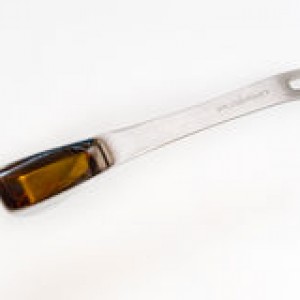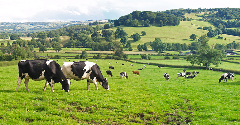News
HFCS more toxic than sucrose, researchers conclude
6 Jan 2015When University of Utah biologists fed mice sugar in doses proportional to what many people eat, the fructose-glucose mixture found in high-fructose corn syrup was more toxic than sucrose or table sugar, reducing both the reproduction and lifespan of female rodents. “This is the most robust study showing there is a difference between high-fructose corn […]

 When University of Utah biologists fed mice sugar in doses proportional to what many people eat, the fructose-glucose mixture found in high-fructose corn syrup was more toxic than sucrose or table sugar, reducing both the reproduction and lifespan of female rodents.
When University of Utah biologists fed mice sugar in doses proportional to what many people eat, the fructose-glucose mixture found in high-fructose corn syrup was more toxic than sucrose or table sugar, reducing both the reproduction and lifespan of female rodents.
“This is the most robust study showing there is a difference between high-fructose corn syrup and table sugar at human-relevant doses,” said biology professor Wayne Potts, senior author of a new study scheduled for publication in the March 2015 issue of The Journal of Nutrition.
The study found no differences in survival, reproduction or territoriality of male mice on the high-fructose and sucrose diets. The researchers say that may be because both sugars are equally toxic to male mice.
Both high-fructose corn syrup found in many processed foods and table sugar found in baked goods contain roughly equal amounts of fructose and glucose. But in corn syrup, they are separate molecules, called monosaccharides. In contrast, sucrose or table sugar is a disaccharide compound formed when fructose and glucose bond chemically.
Potts said the debate over the relative dangers of fructose and sucrose is important “because when the diabetes-obesity-metabolic syndrome epidemics started in the mid-1970s, they corresponded with both a general increase in consumption of added sugar and the switchover from sucrose being the main added sugar in the American diet to high-fructose corn syrup making up half our sugar intake.”
James Ruff, the study’s first author and a postdoctoral fellow in biology, said: “Our previous work and plenty of other studies have shown that added sugar in general is bad for your health. So first, reduce added sugar across the board. Then worry about the type of sugar, and decrease consumption of products with high-fructose corn syrup.”
The new study is the latest in a series that used a new, sensitive toxicity test developed by Potts and colleagues. It allows house mice to compete in the seminatural environment of room-size “mouse barns.” Previous mouse studies with the test found harmful effects of inbreeding, the antidepressant Paxil and, last year, an added-sugar diet with fructose and glucose in amounts proportional to a healthy human diet plus three cans of soda daily. These health effects had been missed by conventional tests.
Potts and Ruff ran the new study with former University of Utah undergraduates Sara Hugentobler, Amanda Suchy, Mirtha Sosa, Ruth Tanner and Megumi Hite; and lab manager Linda Morrison. The other coauthors were nutrition researchers Sin Gieng and Mark Shigenaga at Children’s Hospital Oakland Research Institute in California.
The research was funded by the National Institutes of Health and National Science Foundation.
New Findings Build on 2013 Sugar Toxicity Study
A 2013 study on sugar toxicity found that when mice were fed either a diet with 25% calories in the form of added fructose and glucose monosaccharides or 25% calories from starch, females died at twice the normal rate and males were a quarter less likely to hold territory and reproduce.
The new study compared two groups of mice that were fed a healthy diet with 25% calories from processed sugars. One group ate a mix of fructose-glucose monosaccharides like those in high-fructose corn syrup. The other group ate sucrose.
Female mice on the fructose-glucose diet had death rates 1.87 times higher than females on the sucrose diet. They also produced 26.4% fewer offspring.
The new study found no differences in males on the two diets in terms of survival, reproduction or ability to compete for territory. But Potts said the 2013 study showed male mice were a quarter less likely to hold territory and reproduce on the fructose-glucose mix compared with starch. That, combined with the new findings, “suggests sucrose is as bad for males as high-fructose corn syrup,” he said.
Ruff said it also is possible that “other factors are more important than the differences between these two diets for the males” – possibly inherited differences in ability to hold territory.
Potts says female mice that ate the fructose-glucose mixture may be more likely to die than male mice because they undergo a bigger metabolic “energy crunch” during such studies: on the day they give birth, they mate and conceive the next litter, so they are nursing their first litter while gestating a second litter.
Regardless of sex, the researchers also found no difference between mice on the two diets when it came to food intake, weight gain or glucose tolerance. Sucrose is broken into fructose and glucose monosaccharides before the body absorbs it. So whatever caused the different mortality and reproduction in females on the two kinds of sugar diets, “it has to happen at the point of absorption or before – not once it is in the bloodstream, liver or brain,” Ruff said.
“So we speculate that the different sugars could favour different microbes in the guts of mice. Other research has shown differences in bacterial communities in the gut to be associated with metabolic diseases in rodents and in humans. It’s possible one form of sugar causes more bacteria to get across your gut than another.”
A Sugary American Diet
An estimated 13% to 25% of Americans eat a diet that includes 25% or more of calories in the form of added sugars – the%age of added sugars consumed by mice in the new study. “Added sugars” are sugars added during food processing or preparation and not already naturally in food, like in a piece of fruit.
Ruff says that in the American diet, 44% of the added sugar is sucrose, 42% is high-fructose corn syrup and the remaining 14% includes honey, molasses, juice concentrates and agave – all of which also combine fructose and glucose (which also is known as dextrose). Yet worldwide, high-fructose corn syrup represents only about 8% of added sugar consumption, he adds.
Ruff says a number of previous studies in rodents and people tied pure fructose consumption to metabolic problems such as insulin resistance, obesity and abnormal cholesterol and triglyceride levels. He says those studies concluded high-fructose corn syrup was worse than sucrose, but most compared sucrose only to fructose instead of a more realistic fructose-glucose mix.
And “the few previous studies used much higher doses of sugars that are not particularly relevant to humans, and the effects were slight or small,” Potts says.
The mice in the new study were unrelated, house-type mice, rather than inbred lab mice, because the former compete with each other naturally. For about 40 weeks, mice were fed either the healthy diet with 25% of total calories as added fructose and glucose monosaccharides or as sucrose.
Then 160 mice were released into six mouse barns to compete for food, territory and mates for 32 weeks. Each of the 377-square-foot mouse barns held eight to 10 male mice and 14 to 20 females.
Each mouse barn was divided by wire mesh into six territories, each with either an open or protected nest box. Males competed for the better territories and protected nests. Implanted radio chips and antennas at feeders kept track of where mice fed and thus the territories they occupied. The researchers periodically checked for and removed dead mice, as well as pups so they would not breed.
After eating different sugar diets before entering the mouse barns, all the mice ate the fructose-glucose monosaccharide diet while competing in the barns, where they roamed together and couldn’t be kept on different diets. If there were harmful effects from the fructose-glucose diet before entering the mouse barns, they might be obscured if all the mice ate the sucrose diet once in the barns.
Related news

Has ‘clean’ had its day?
22 Dec 2025
Wielding clean-label positioning and fortification as marketing levers is a dangerous strategy, and brands would be better off explaining the hows and whys of the ingredients in their products, say experts.
Read more
Celebrating the winners of the Fi Europe Innovation Awards 2025
3 Dec 2025
Food industry stakeholders celebrated as the winners of the Fi Europe Innovation Awards were announced at a ceremony in Paris.
Read more
Alternative protein startups pivot to B2B ingredients amid funding shift
27 Nov 2025
Alt protein startups are pivoting from consumer meat analogues to high-value B2B ingredients, driven by stronger investor interest, better margins, and clearer commercial pathways.
Read more
Walmart Marketplace’s record growth prompts search for UK sellers
26 Sep 2025
Walmart’s third-party e-commerce platform, Marketplace, has witnessed extraordinary growth – but a need for more product diversity has prompted the retailer to recruit UK sellers.
Read more
The winners of Vitafoods Europe Startup Challenge 2025 revealed
29 May 2025
Four startups – Yomio Drops, PFx Biotech, Revobiom, and Favamole – took top prizes at this year’s Vitafoods Europe Startup Challenge awards.
Read more
East takes on West in the fight for future food flavours
30 Apr 2025
Asian and South American flavours are now key components on global menus, driven by a growing global appetite for culinary mashups.
Read more
Food companies urged to bring ‘joy’ and urgency to healthy food mission
14 Mar 2025
For too long, businesses have treated health and sustainability as separate agendas – but there is growing evidence to show diets that benefit human health can also enhance that of the planet, say experts.
Read more
Entries open for inaugural Vitafoods Europe Innovation Awards
29 Jan 2025
Entries are open for the inaugural Vitafoods Europe Innovation Awards, celebrating the ingredients, finished products, partnerships, and initiatives redefining the nutraceutical landscape.
Read more
Paris Olympics: Food and beverage brands champion health, fun, and sustainability
5 Aug 2024
Food and beverage brands are aligning with the Paris Olympics 2024 Food Vision, which emphasises sustainability, local sourcing, and plant-based diets.
Read more
Natural Remedies: Bringing health and happiness via validated branded ingredients
18 Apr 2024
Natural Remedies is an internationally renowned botanical healthcare company committed to advancing the field through rigorous research and the development of clinically validated Branded Ingredients. Guided by our foundational principle of ‘BEING USEF...
Read more